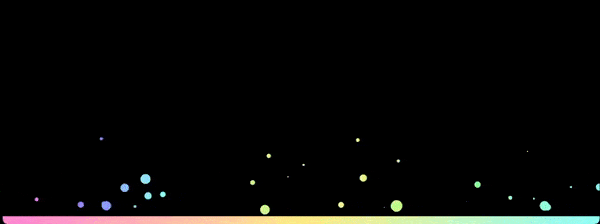Particles are generated through a Particle Class which has an update and a draw method:
class Particle {
constructor() {
const lerp = (x, y, a) => x * (1 - a) + y * a;
const clamp = (a, min = 0, max = 1) => Math.min(max, Math.max(min, a));
// inverse function of lerp
const invlerp = (x, y, a) => clamp((a - x) / (y - x));
this.x = Math.random() * canvas.width;
this.y = canvas.height;
this.size = Math.random() * 15 + 1;
this.speedX = 0;
this.speedY = Math.random() - 1.5;
const percentageFirstHalfCanvasWidth = invlerp(0, canvas.width / 2, this.x);
const percentageSecondHalfCanvasWidth = invlerp(
canvas.width / 2,
canvas.width,
this.x
);
if (this.x < canvas.width / 2) {
// see hsl values of the linear-gradient property
this.hue = lerp(322, 52, percentageFirstHalfCanvasWidth);
} else {
this.hue = lerp(52, 178, percentageSecondHalfCanvasWidth);
}
}
update() {
this.x += this.speedX;
this.y += this.speedY;
this.size > 0.2 && (this.size -= 0.1);
}
draw() {
ctx.fillStyle = "hsl(" + this.hue + ", 100%, 76%)";
ctx.beginPath();
ctx.arc(this.x, this.y, this.size, 0, Math.PI * 2);
ctx.fill();
}
}The animation is achieved through a recursive function:
const animate = () => {
ctx.clearRect(0, 0, canvas.width, canvas.height);
handleParticles();
requestAnimationFrame(animate);
};Lerp function
The color of the particle (this.hue) will be determined by the x position of the particle using the lerp function (linear interpolation between two values). The color range goes from pink to yellow (first half of the canvas width) and from yellow to blue (second half of the canvas width). See the CSS linear-gradient property.
